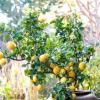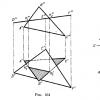Tangit thread. Universal thread tangit uni-lock is a new generation thread sealant. Resistance to aggressive environments
Tangit Unilock thread is a general purpose thread seal for pipe threaded connections. The product is a non-curing (ready-to-use) multifilament fiber sealant that is wound directly from the dispenser kit onto the threads of pipeline fittings. The product comes in convenient containers that serve both storage and distribution of the sealing product. The product meets the requirements of regulatory documents allowing its use in water and gas environments (KTW and DV - Germany, BS - Great Britain) and provides effective sealing of pipe threaded connections immediately after installation.
TYPICAL APPLICATIONS Threads Tangit Unilok
Sealing threaded elements (according to ISO 7/1), such as couplings and pipeline fittings, both cylindrical and conical threads, used in pipelines for the transport of aqueous and non-aqueous media at temperatures up to 130 C. The product Tangit Unilok Thread can, in particular , used in situations requiring prompt installation of threaded elements with subsequent minimal adjustment before operation. Recommended for use on pipeline fittings with a maximum outside diameter of 6".
STORAGE
Until use, containers with Thread Tangit Unilok should be stored hermetically sealed. Long-term storage of containers should be carried out in a dry place. Detailed information about the shelf life of the product can be obtained from your regional Loctite representative.
PRODUCT DESCRIPTION
Coated filament fiber Tangit Unilok thread
TECHNICAL SPECIFICATIONS Thread Tangit Unilok
Qualification tests according to EN 751-2 specifications for Arp class connections.
| Chapter | Description | Result |
| 7.2.1.2 | Test for absence of defects | no leaks |
| 7.2.1.3 | Test for absence of defects after turning the fitting at an angle of 45 C |
no leaks |
| 7.2.1.4 | Resistance to gas condensate | no leaks |
| 7.2.1.5 | Hot water resistance | no leaks |
| 7.2.1.6 | Thermal cycling test (resistance to temperature changes) | no leaks |
| 7.2.1.7 | Vibration test | no leaks |
| 7.2.2 | Leak test with soap foam | no leaks |
| 7.2.3 | Test for sticking and peelability | no leaks |
RESISTANCE TO AGGRESSIVE ENVIRONMENTS
The product Thread Tangit Unilok is resistant to gases classified as aggressiveness categories 1, 2 and 3, hot and cold water.
GENERAL REMARKS
The product Thread Tangit Unilok is not recommended for use in an environment of pure oxygen and/or in conditions of high oxygen content, as well as sealing material in the presence of chlorine and other strong oxidizing agents. For information on handling the product, see the Safety Information Sheet.
CERTIFICATION
This product has been tested and meets the requirements technical specifications EN 751-2 for class Arp connections, which form the basis of the DVGW standard (AZ Certificate No. 98/250/5142/1), and is certified for use in pipeline equipment and pipelines for the transport of drinking water in accordance with the KTW standard for cold and hot water. In addition, the product meets the requirements of the BS 6920 (1996) drinking water standard. Copies of certification certificates can be obtained from your regional Henkel office.
DIRECTIONS FOR USE
Tangit Unilok thread is wound onto the pipeline thread in the direction of the thread turns, starting from the edge of the pipe or fitting. For effective use, threaded grooves should be filled with thread so that the threads remain visible. The thread is trimmed after winding using a knife in the lid of the container. The thread in the container has a spiral winding and is easy to unwind. When winding Tangit Unilok thread onto threads, it is necessary to ensure sufficient tension. Before winding Loctite 55 sealing thread, the smooth surface of the thread must be lightly sanded.
NOTE
The data contained is for informational purposes only, but corresponds to the actual properties of the material. Loctite is not responsible for results obtained by other organizations as it has no control over the conduct of such tests. When using the product, the consumer bears full responsibility for the quality of its operation and labor safety during production processes.
When considering warranty cases for products for which the product is used, Loctite does not bear any liability, including moral and other damages associated with the quality of the manufactured product. Loctite recommends that manufacturers, when introducing a product into a technological process, carry out the necessary tests, guided by the above data. The product may be covered by one or more U.S. or other foreign patents or patented uses.
Henkel Group is a German chemical company operating in three areas: cleaning products, cosmetics and personal care products, and bonding technology.
Everyone who deals with plumbing uses thread sealing tools that are convenient for them - some like to work with fum tape, others are satisfied with flax, and also a special thread that has a lot of advantages over them.
At work we often encounter distrust of everything new, and it happens that the customer is categorically against it Tangit and insists on winding the pipe with a washcloth and paint, and you have to put up with it. No matter how much I work with her, I am sure that this is a relic of the past.
What is Tangit Unilok:
It looks exactly like dental floss - there is a cutter knife installed on the outside, which cuts off the required length, and inside there is a spool of thread itself. This thread is made of durable synthetic material, quite thick and well impregnated with a special silicone-based paste. The box is completely closed and has a lid on top, which prevents dust from getting into it.

Ideal thread sealant:
Unlike the same flax, with Uni Lock it is much easier and faster to work - it fits tightly onto the thread in an even layer, does not tear and there is no need to moisten it additionally. The number of revolutions depends on the quality of the groove (the worse, the more you need), but in any case, its consumption is greater than indicated by the manufacturer. On average, 8-10 turns are enough to prevent the connection from leaking.

The thread is universal in use, so it can be used with both gas and water, as described in the instructions.
How to wind a thread onto a thread:
You need to start from the edge, throwing turns crosswise along the thread. The layer should be distributed as evenly as possible. If the connection assembly is difficult, it is better to remove the excess winding. After fixing, you can disassemble the connection at any time and reassemble it. It can withstand two times quite well.
Pros:
- Doesn't tear
- Does not require lubrication
- Re-installation possible
- Convenient to use in hard-to-reach places.
Cons:
- Expensive

Common name TANGIT UNI LOCK- differs in smaller packaging.
| 1. Clean the thread and roughen it if necessary. 2. Starting at the end of the pipe, wrap Loctite 55 onto the pipe threads in the same direction as the helix thread. To achieve best results Do not insert the sealing thread directly into the thread groove. Wind the cord around the thread and try to tighten it. 3. Cut the required length of thread using the knife built into the dispenser. Smooth the free end into the threads. 4. Attach the female thread fitting. 5. Tighten with a wrench until it stops. If necessary, the assembled units can be adjusted. |
|
|
Recommended amount of thread depending on thread diameter (metal)
*The number of threads may vary for threads not conforming to DIN 2999-1 or ISO 7/1.
Plastic pipe threads require at least twice as much material as recommended for metal threads.
- Before applying the product, degrease, clean and dry the surfaces of the parts - what the product can be used for Loctite 7063 (150 mlor400 ml).
- It is not recommended to use activators and cleaners from third-party manufacturers, becausetheir chemical composition may not be compatible with Loctite anaerobic products
Loctite Liquid Threadlocker Average Consumption Chart
In practice, when filling threaded gaps of 0.1 mm (in M3-M10 threads) and 0.2 mm (in M20-M30 threads), the product consumption increases by 20% of the above.
The above table provides information on the estimated consumption of Loctite thread sealants for various applications. The practical consumption of Loctite thread sealants will depend on the actual gap in the connection, differences in viscosity due to temperature changes, as well as certain product losses during technological process. Taking into account the above, in order to normalize product consumption during the production process, it is recommended to carry out preliminary test assemblies.
Example of applying liquid thread sealant
Go to cart
Characteristics
- Type of material: treated polyamide multi-filament thread.
- Temperature/pressure resistance:
Gas: from -20 o C to +70 o C, ≤ 5 bar;
Hot water: up to +130 o C, ≤ 7 bar;
Drinking water: up to +85 o C, ≤ 16 bar.Universal thread for sealing Tangit UNI-LOCK 20 meters
- This product has been tested and complies with EN 751-2 for connection class ARp, which forms the basis for DVGW approval (Certificate No. NV-5142BP5597).
- The product has been approved for use in pipe fittings (gas, cold and hot water). In addition, it has drinking water approval to BS 6920 (1996).
- Resistant to gases of groups 1, 2 and 3 (group 3 in the vapor phase), hot and cold water, gas condensates, compressed air and industrial oils.
Areas of application
- Tangit Uni-Lock thread is a universal material for sealing threaded pipes.
It allows sealing of threaded assemblies (ISO 7-1), such as couplings and pipe fittings with both cylindrical and tapered threads.
- Operating range: supply of cold and hot water up to 130 o C and gas.
- Tangit Uni-Lock is especially useful in applications where threaded connections need to be ready for use immediately and allow for minor adjustments before use.
- Not recommended for use in systems with pure oxygen and/or oxygenated, as well as for chlorine or other strong oxidizers, gasoline, diesel fuel or fuel oil.
Application
- Preparing threads for sealing:
If necessary, use a brush to clean the metal threads. Before starting the wrapping operation, it is recommended to file the metal threads. - Application:
The tape is wound onto the thread in the direction of the thread turns, starting from the end of the pipe. The thread grooves should be filed using a file and then the threads should be wrapped without necessarily getting into the grooves. The tape can be cut using the cutting edge provided on the lid of the container. The tape is wound spirally in the container and will unwind without effort. Make sure the product is applied with some tension.
Consumption
Package
Distribution container containing 20, 80 or 160 meters of thread. The container is equipped with a convenient knife for cutting the thread. Containers should be kept tightly closed until ready to use. For long-term storage Containers should be kept in a cool, dry place.
Characteristics
- Type of material: treated polyamide multi-filament thread.
- Temperature/pressure resistance:
Gas: from -20oC to +70oC, ≤ 5 bar;
Hot water: up to +130oC, ≤ 7 bar;
Drinking water: up to +85oС, ≤ 16 bar. - This product has been tested and complies with EN 751-2 for connection class ARp, which forms the basis for DVGW approval (Certificate No. NV-5142BP5597).
- The product has been approved for use in pipe fittings (gas, cold and hot water). In addition, it has drinking water approval to BS 6920 (1996).
- Resistant to gases of groups 1, 2 and 3 (group 3 in the vapor phase), hot and cold water, gas condensates, compressed air and industrial oils.
Areas of application
- Tangit Uni-Lock thread is a universal material for sealing threaded pipes. It allows sealing of threaded assemblies (ISO 7-1), such as couplings and pipe fittings with both cylindrical and tapered threads.
- Operating range: supply of cold and hot water up to 130oC and gas.
- Tangit Uni-Lock is especially useful in applications where threaded connections need to be ready for use immediately and allow for minor adjustments before use.
- Not recommended for use in pure oxygen and/or oxygenated systems, chlorine or other strong oxidants, gasoline, diesel fuel or fuel oil.
Application
- Preparing threads for sealing:
If necessary, use a brush to clean the metal threads. Before starting the wrapping operation, it is recommended to file the metal threads. - Application:
The tape is wound onto the thread in the direction of the thread turns, starting from the end of the pipe. The thread grooves should be filed using a file and then the threads should be wrapped without necessarily getting into the grooves. The tape can be cut using the cutting edge provided on the lid of the container. The tape is wound spirally in the container and will unwind without effort. Make sure the product is applied with some tension.
Consumption
Package
Distribution container containing 20, 80 or 160 meters of thread. The container is equipped with a convenient knife for cutting the thread. Containers should be kept tightly closed until ready to use. For long-term storage, containers should be kept in a cool, dry place.
Documents
Tangit Uniloc instructions for use
How to properly wrap threads with flax?
The most important thing in this matter is not to overdo it - if you wind too much flax, the resulting connection may burst, if you wind too little flax, it may leak. It is necessary to maintain a golden mean; all this comes with practical experience.
How to use sealing paste correctly - how to use Unipak?
Manufacturers recommend spreading the paste onto a pre-cleaned thread, then winding flax on top, spreading another layer of unipak on top. It can be done simpler without compromising the quality of the connection. For example, either spread flax only on top, or dip the entire strand in sealing paste - the effect will be the same.
The flax should be screwed onto the threaded connection in a clockwise direction so that it does not unwind when screwing the parts. After the flax has been wound and sealing paste has been smeared on it, the connection must be carefully tightened together with two keys and proceed to the next stage of work.
How to wind the thread?
To seal the joints, you can use your choice of flax and plumbing paste. In this case, it is necessary to keep in mind that flax is not suitable for pipelines designed for operation at temperatures above 90 degrees, because it burns out over time, losing its properties. You can use TANGIT Uni-Lock thread or its equivalent. The blister pack confidently states that 20 meters is enough to seal 50 connections for 1/2-inch threads. The analogue - "Plumbing" at the same cost has 50 meters and is sold in almost any store like Leroy-Merlin.
You can use polyamide thread in combination with silicone lubricant. The branded TANGIT Uni-Lock consists of polyamide thread and silicone, so you can easily save money by taking a regular thick polyamide thread and silicone or plumbing grease at any hardware store.
Tangit uni lock - a revolutionary thread
Linen, jute rope or a similar analogue made from plant materials can be purchased on occasion at a hardware store, spending about the same amount for the same 50 meters.
When using silicone sealant, you must keep in mind that it hardens quite quickly, so after a short period of time it will no longer be possible to adjust the connection; such sealant will simply break inside the thread. For these reasons, the sealing filler should neither harden nor wash out.
Another interesting point - silicone sealants acetic-based products cause metal corrosion; this must be taken into account when choosing materials.
The easiest way to decide what is suitable for sealing and what is not is to experiment first.
How to wind?
For professionals, this is a matter of habit - some wind it crosswise, some strictly follow the instructions detailed in the instructions, and the most important thing is that you need to wind it tightly, so that the thread is completely covered with the material used, in which case nothing will leak. However, the thread wound against the thread may be damaged when tightening the nut.
To wind flax, you need to separate a small strand the thickness of one or two matches, smooth it out, select and discard small fibers. You can twist the strand into a cord. Then wind it very tightly along the thread, starting from the edge of the thread, so that the thread groove is completely closed. After this, you will need to take plumbing paste and spread it onto the linen with rotational movements. If everything was done carefully during the work, then everything will definitely work out. All that remains is to tighten the connection using a little force. If the nut tightens easily, it means that either a small amount of flax was wound, or there was too much gap between the internal and external threads. Everything will need to be disassembled and rebuilt again. If the work was done correctly, the flax will not stick out, and you will get a reliable and airtight connection.
Simply wind the TANGIT Uni-Lock thread crosswise or wind it along the thread 6-8 turns and connect the parts together - the work will be completed.
In the homemade version, the polyamide thread must be wound and coated with plumbing paste or silicone grease. You can pre-impregnate the entire skein of polyamide thread with silicone grease, then wind it around the joint and connect the parts. The soaked skein can then be placed in plastic packaging so that it does not stain anything, does not dry out, and nothing unnecessary sticks to it.
For work, the linen rope needs to be separated into two cords, cut off 40-50 cm from it, wound around the thread, lubricated with plumbing paste and tighten the resulting connection. It is possible to understand what is better to use in the process - a synthetic thread - TANGIT Uni-Lock or another analogue - only if you have the appropriate experience.
Tangit Unilok thread is a new generation sealant for threaded connections of metal and plastic pipes (cold and hot water, gas).
Thanks to the capabilities of Tangit Unilock, you can adjust the pipe connection even after winding the sealant, within 72 hours - the strength of the connection will not be impaired.
How to wind tangit unilock
Before sealing with tangit, you should prepare the thread - clean it with a brush, and if necessary, file it.
In one hand, take the product on which the sealant will be wound (a coupling, for example), and in the other - the Tangit Unilock thread itself. Pinch the tip of the thread with one finger and begin to wind the tangit from the end of the pipe (the beginning of the thread) towards the depth of the thread. In the container, the thread is wound in a spiral and unwinds without effort.
The wound thread should be accumulated at the beginning of the thread, since when tightening threaded connection, the tangit unilok thread moves under the influence of force deeper into the thread. And in order to distribute the sealant evenly, it is necessary to create a thicker layer of thread at the beginning.
There is no point in winding a lot of thread; just a few turns are enough. The recommended number of turns is written on the instructions for using the sealant.
Use the sharp edge of the container to cut the thread. Simply smooth the end of the thread onto the thread with your finger.
Instructions for use

To visualize the process of winding tangit uni lock sanitary thread, watch the video clip at the end of the article.
Advantages of tangit uniloc thread
"Tangit Uni-Lok" is the latest sealant consisting of polyamide thread and treated with a silicone coating.
The advantages of Tangit Unilock are obvious:
- used for all types of threads;
- ease of use;
- instant sealing after implementation;
- the ability to adjust the connection after implementation;
- used for fittings (up to 6 inches);
- can be used to connect gas pipes and drinking water supply;
- permissible temperature of use is from -20°С to +130°С.
Video: sealing a threaded connection with tangit
Read our next article on how to wind tow on a thread.
Read also...
- What are the reasons for the successful military campaigns of the Mongols?
- Intersection of two planes
- Why do you dream of white doves: for the fulfillment of desires, meeting true love Seeing white doves in a dream
- I dreamed of a white dove - interpretation of the dream according to the dream book. What does it mean when you dream of a white dove




















